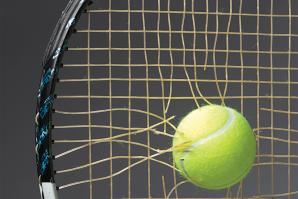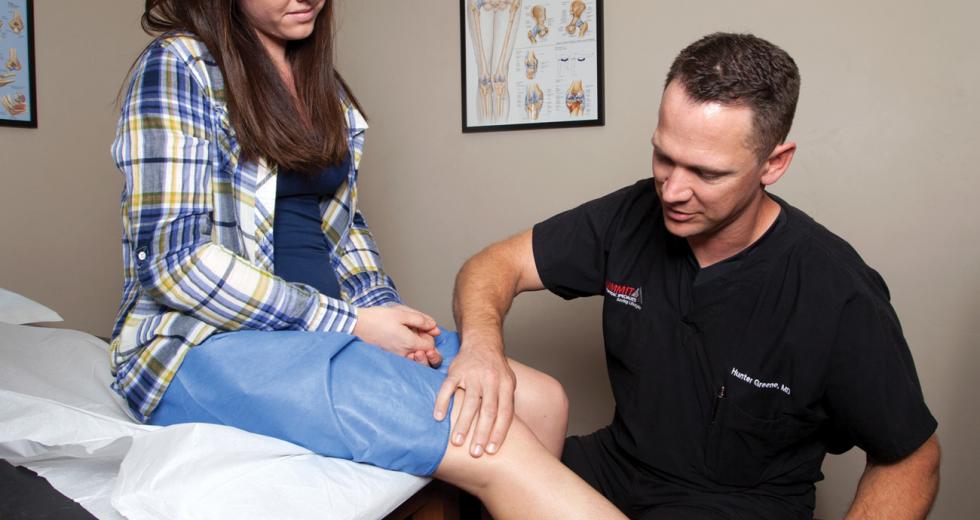While you’re reading this article, someone will tear an anterior
cruciate ligament. It’s also likely that person is a woman.
Roughly 200,000 Americans tear their ACL every year, about one
every 3 minutes. The headlines at ESPN focus on the splashier
injuries like Adrian Peterson or Derrick Rose, but the far more
common scenario is a high school gymnast who jumps off the
balance beam, feels a pop in her knee, fights back tears, sees a
doctor and soon discovers that her sport — which once gave her
purpose and pride — has been swapped for a year of
soul-crushing rehab.
In one of the crueler twists of sports, ACL tears often happen in freak accidents that you can’t really control. Seventy percent occur without contact. Even more cruelly, women are four times more likely than men to tear the ligament — especially if she’s young and active. “This is an injury that happens to young people,” says Dr. Stephen Howell, who performs ACL surgeries at Methodist Hospital in Sacramento. “They have a long life ahead of them. It’s a devastating injury at a very young age.”
The good news? Researchers now have a better grasp of why women are at greater risk. This knowledge, coupled with advances in ACL surgery and treatment, could help female athletes come back faster, stay healthier longer and maybe — maybe — even dodge the injury altogether.
Why women?
The anterior cruciate ligament is, of course, that all-important rope of flesh that snakes through your knee and connects the femur (thigh bone) with the tibia (shin bone). It’s crucial for stability and control. It can tear when an athlete lands funny after a jump, cuts, pivots or quickly changes direction. Jump-happy sports like volleyball, basketball and gymnastics have the steepest risk, but then again, since WebMD lists additional causes as “stepping off a curb” and “missing a step when walking down a staircase,” the only bulletproof way to prevent an ACL injury is to stay firmly planted on the sofa.
Puzzled by the injury’s gender gap, researchers put athletes through a battery of jumping, cutting and landing drills and then analyzed their movements with cameras and motion-analysis software. They discovered that women land more knock-kneed than men, with their knees bent inward. “[Women] sustain more of a valgus loading force, which means that their knees buckle inwards. Men tend to land with their knees somewhat flexed, which tends to protect the ACL,” says Dr. Richard Marder, an ACL expert at UC Davis.
The reason boils down to a quirk in anatomy. “Female athletes typically have a different ratio of quadriceps strength to hamstring strength. Women have a 2-to-1 ratio; their quadriceps are twice as strong as their hamstrings,” says Dr. Marder. “Men have a 3-to-2 ratio, so their hamstrings are relatively stronger.” Without these other muscles pulling their weight, there’s more stress on the ACL, and women are therefore more “ligament dominant.”
Other contributing factors: women have less “trunk stability” (putting even more force on the knees), the size of the ACL itself might be smaller and hormones could play a role. “Studies have demonstrated that certain [hormone] levels can increase laxity in the knee joint of women during the menstrual cycle,” writes Dr. Thomas Haverbush in Online Orthopedics. “Some have concluded that such laxity could possibly be a factor in increased risk of ACL tears.”
The comeback
“The knee joint is the most controversial joint in the body,” says Dr. Howell, and it has been for more than a century. In 1895, Dr. A.W. Mayo Robson performed the first ACL repair on a 41-year-old miner who busted his knee in a coal pit. After this operation, allegedly, the miner could run without a limp. This kicked off a debate of “repair vs. replacement,” as a few years later, Dr. F. Lange performed the first ACL replacement, swapping out the torn ligament with a braid of silk. (It didn’t take, and silk replacement surgery never really became a thing.) After decades of trial and error, surgeons concluded that repairing the ligament is rarely effective. Once torn, it’ll never again be sturdy enough, so doctors instead focused on constructing a new ACL and then grafting it into the knee.
This isn’t an easy trick. Doctors can build this new ACL in one of two ways: they can graft chunks of flesh from your own body (called an autograft, it’s typically a tendon plucked from your kneecap or hamstring), or they can graft tissue from a cadaver (called an allograft. Sadly, they didn’t call it the way more fun “zombie-graft.”) Once they’ve built this new ACL, the surgeon cuts a few tiny holes into the knee. Then she drills into the upper and lower leg bones, creating a “tunnel” of sorts. The graft is then inserted into this tunnel and fastened at both ends with screws. Voila! (Pro tip: This is just a summarized overview, so don’t try the operation at home.)
As the quality of the grafts has improved so has the quality of the surgery. “Studies have shown that in a young person, the use of a cadaver graft is associated with a higher risk of re-injury,” says Dr. Marder, as the cadaver’s “sterilization process” — the cleansing necessary to make it less zombie-like — might weaken the new ligament. For athletes under 30, surgeons now typically use auto-grafts and see boosted results.
But the real game-changer is an improvement in tunnel placement, the ability for surgeons to drill inside the knee more accurately. “Tunnel placement is really the meat of the outcome,” says Dr. Howell. The precise placement of the graft is crucial. If a graft is too far forward or too far back — every millimeter counts — a basketball player’s knee could be wobbly. Poor tunnel positioning could also contribute to longer-term repercussions, such as arthritis, which could occur in half of all ACL patients.
A new method called the all-inside technique gives surgeons the ability to meticulously sculpt these tunnels, which means a smaller footprint and a less-invasive surgery. “Originally, they used a 2-incision, open approach,” says Dr. Hunter Greene, an orthopedic surgeon at Summit Orthopedic Specialists in Carmichael. They cut open the front part of the knee, then the top and then, through this tunnel, they affixed the graft. (Think of a plumber and pipes. To access the middle of the pipe, they’d have to awkwardly snake at it from an open end.)
Enter a new tool: the flip cutter. Instead of affixing the graft through one end of the tunnel, doctors can now drill directly into the middle of the tunnel with a tiny, 3-millimeter drill-tip that pokes into the knee and then “flips” 90 degrees, like a periscope. Once it flips inside the knee, this drill extends to become a blade and can be used for interior cutting. (Now the plumber can cut directly into the middle of the pipe, allowing for greater control.)
“It’s a very ingenious device, and I wish I had invented it,” says Dr. Greene. Also ingenious are biological screws used to affix the graft. The screws will eventually, seemingly magically, turn into bone.
Better surgery coincides with faster rehab. It takes several
weeks for the graft — which, remember, was once just a chunk of
your kneecap, or maybe a corpse — to become less like a tendon
and more like a ligament. “In the past, you put people in a cast
for six weeks. Then they’d have to regain all that strength,”
says Dr. Greene. Now, the time can be used more efficiently.
(This type of insta-rehab is partly how Adrian Peterson, just
eight months after tearing his ACL, stormed back in time to lead
the league in rushing 2,097 yards, or the second-highest total in
NFL history.)
“While the graft is getting stronger, instead of staying idle you
can now do neuromuscular retraining, so that the muscles know how
to fire the right way to protect the ACL. They can also work on
hip and core stability, which is so crucial, especially in the
female athlete.”
A new focus on the hips and core could also prevent ACL injuries. “Prospective studies show that neuromuscular training has the potential to decrease ACL injury rates in females,” writes Dr. Timothy Hewett, an early champion of the research, in the American Academy of Orthopedic Surgeons. “Movement biomechanics (the body’s ability to move) and knee strength can be altered in female athletes with neuromuscular training. Neuromuscular power can increase within six weeks of training and may reduce peak impact forces.”
Dr. Greene is also a believer. “If you retrain female athletes, you can actually condition them, through jump-training exercises, to land in a way that’s more protective to the ACL,” he says. “You can’t change the hormone cycles, and you can’t change the anatomy but there’s more and more evidence that you can change the muscle-firing patterns to prevent injury.” Or, to paraphrase Steve Harvey: Jump like a lady, land like a man.
Not everyone is fully convinced. “Frankly, I think a little of this is marketing,” says Dr. Howell. “It’s been very controversial.” That goes with the ACL territory. There’s still scholarly disagreement on how long athletes should wait before coming back, whether a knee-brace should be used and whether the surgery itself prevents (or even causes) arthritis.
So what’s next?
It still takes athletes at least six months to return competitively to their sport. So what breakthroughs lie ahead that can help a 16-year-old volleyball player return to her team in time for the playoffs?
“Today we can control the tunnel positions, we can control the graft size and we can control how it’s fixed into the bone. But we can’t control how it heals into the bone,” says Dr. Greene. “The next big step is going to be on the biologic side.”
In an ACL surgery, we’re asking one body part (an old tendon) to mutate into something else (a ligament), so the faster this mutation happens, the faster the gymnast gets back on the balance beam. Lab-coated R&D scientists are questing for the holy grail of ACL surgery: growing a new ligament from scratch. Instead of using a graft from a cadaver or a tendon from your knee, they would create a new one from your body’s own naturally created stem cells.
“When you drill into the bone, it bleeds,” explains Dr. Greene. This blood contains stem cells, and “stem cells can become anything they want. They can become kidney cells, they can become liver cells, they can become bone cells, depending on what signal they get. We don’t yet know what signal it takes to turn a stem cell into a lung cell or a bone cell. Once we understand that signaling pathway and how to turn them on to work for us, then it would heal faster.” He ballparks that this might happen in the next five to 10 years.
So what would this mean to the 200,000 gymnasts, skiers and basketball players who tear their ACL each year? What would it mean to the athlete who just tore her ACL in the last three minutes? (Then again, if she had neuromuscular jump training… maybe she didn’t.) Theoretically, a stem cell-created ACL could mean lower failure rate. It could mean quicker rehab. It could mean that she heals faster than Adrian Peterson. Dr. Greene says that he feels for the “15-year-old girls who sit in my office and cry when they hear they’re not going to play soccer for nine to 15 months. It’d be much more bearable if it’s only three.”
Recommended For You

Love Hurts
The pain of learning tennis is more than worth the health gains
It started with a girl. She had played tennis in college. Desperate to impress her, I challenged her to a match. Sure, I had never played, but I could hold my own.

Figure of Speech
How body language factors into the glass ceiling
He’s the boss, she’s bossy. He’s assertive, she’s domineering. He strategizes, she schemes. He’s powerful and likeable, she’s powerful or likeable.



